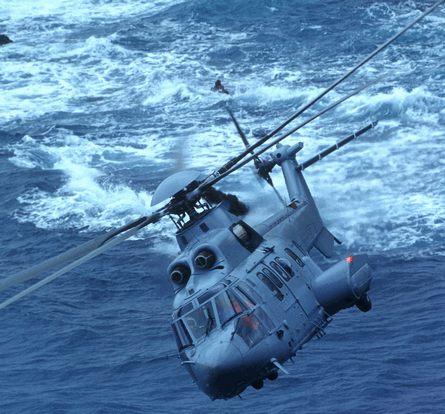The purchase of McAlpine Helicopters and its subsequent rebranding as Eurocopter UK is an important step for the European helicopter giant, says senior executive vice president Philippe Harache. “It increases our fighting power, if you can call it that, for the UK market and is part of our strategy to strengthen our focus in the UK. Farnborough is the ideal place to tell that story.”
Eurocopter is no stranger to the UK and Ireland and has approximately 75% of the total law enforcement ‘air support’ fleet. The UK’s Metropolitan Police Service is one of a handful of police forces to operate the EC145 in such a role – historically, the law enforcement missions have been supported by the smaller EC135 and the AS355 Squirrel. The company also has an expanding corporate helicopter presence.
It is future UK military requirements which provide the largest opportunities for Eurocopter, however, with the UK’s long-standing need to equip itself with a next generation search and rescue (SAR) capability high on the list through the SAR-H competition.
“We are proposing the EC725 as a platform to the consortia bidding for SAR-H,” says Harache. “We also see the NH90 as a natural contender for the UK’s medium helicopter requirement.” Eurocopter hosted a customer seminar on SAR solutions in Brighton on the UK’s south coast in April, where a French army EC725 carried out demonstration flights.
 |
|---|
© EurocopterEurocopter believes the EC725 could be a solution for the UK’s search and rescue requirement. |
Three consortia are bidding to win the SAR-H contest, which will be worth as much as £5 billion over the next 30 years. Aircraft are due to enter service in 2012. Away from the UK, Eurocopter has spent the last two years strengthening its presence in the Far East with strategic alliances forged both in Korea and China. “This is no coincidence,” Harache says. “It is clear that Korea and China, along with India, are among the most important emerging economies in the region. The two programmes are very important to us.”
The two programmes he refers to are the Korea Helicopter Programme (KHP), where Eurocopter is teamed with Korea Aerospace Industries and the development of the 7 tonne EC175 heavy twin in co-operation with Harbin, part of AVIC II in China.
KHP has entered the detailed design phase, with a joint management company set up in-country. Eurocopter currently has up to 50 engineers and support staff based in Korea as the programme gears up towards first flight in late 2009 or early 2010. The next stage is to integrate major dynamic components, with the modified engine due to be integrated in the second half of 2009.
Harache says that a procurement contract for the exact number of aircraft has yet to be signed, but that Eurocopter has a working assumption of a domestic Korean requirement for up to 250 aircraft. The partnership hopes to increase that figure to 500 units through international sales.
Eurocopter has 111 confirmed deposits on the EC175 with the market demand outstripping initial predictions by some distance, according to Harache. “We knew the aircraft would attract attention, but not to this extent. The oil and gas market is an important sector for the EC175 but we are also seeing strong demand for SAR missions and also VIP transportation.”
The aircraft completed its critical design review at the end of 2007, with the maiden flight due next year and type certification in 2011. In the USA Eurocopter expects to deliver 36 UH-72A Lakotas to the US Army this year under the terms of the $2bn Light Utility Helicopter contract it won in 2007. The UH-72A is a military copy of the EC145 and Eurocopter is modelling the production line in Columbus, Mississippi on its plant in Donnauworth, Germany. Despite some sceptics, the results are positive so far, with all deliveries on time or ahead of schedule.
Harache explains: “The programme is developing extremely well. The current requirement is for 322 aircraft, but we believe there are other opportunities. We have great expectations. There is very little development work required because the EC145 is a perfect mission fit.” He adds: “We have always seen the USA as a critical market. We have grown our market share over the years and we are selling more aircraft than ever, but there is more potential to come.”
Continuing to make inroads into the US market is not being made any easier for Eurocopter with the current comparative values of the US Dollar and the Euro. “Most of our costs are in Euros, which does not help our competitiveness,” says Harache, “There are things we are doing to combat this, but the most important aspect is to stay ahead in other areas – in performance, in operating cost, in customer satisfaction. It’s also about offering helicopter solutions, not just aircraft.”
Harache says that Eurocopter’s very high order backlog, currently standing at close to £10bn, is both a strength for the business and a challenge. “We are ramping up production to meet demand and we would expect to deliver in excess of 600 aircraft in 2008.
“This is the fifth year in a row that we will record double digit sales growth. That means we will continue to have very high levels of industrial activity for the foreseeable future. There are some tensions on the employment market but we are still managing to reinforce the business with the right quality and quantity of people. That is also important to meet the order backlog.”
He adds: “We also have a balanced order book between civil and military. Sometimes it is 52% to 48% in favour of one and sometimes the reverse, but it is always close to 50:50. That is a big part of our strategy, to have good balance in the portfolio of products.”
Source: Flight International
















